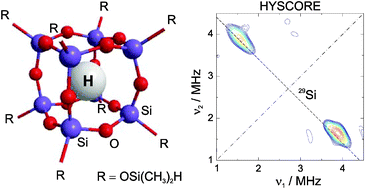Hydrogen atoms encapsulated in molecular cages are potential candidates for quantum computing applications. They provide the simplest two-spin system where the 1s electron spin, S = 1/2, is hyperfine-coupled to the proton nuclear spin, I = 1/2, with a large isotropic hyperfine coupling (A = 1420.40575 MHz for a free atom). While hydrogen atoms can be trapped in many matrices at cryogenic temperatures, it has been found that they are exceptionally stable in octasilsesquioxane cages even at room temperature [Sasamori et al., Science, 1994, 256, 1691]. Here we present a detailed spin–lattice and spin–spin relaxation study of atomic hydrogen encapsulated in Si8O12(OSiMe2H)8 using X-band pulsed EPR spectroscopy. The spin–lattice relaxation times T1 range between 1.2 s at 20 K and 41.8 μs at room temperature. The temperature dependence of the relaxation rate shows that for T < 60 K the spin–lattice relaxation is best described by a Raman process with a Debye temperature of θD = 135 K, whereas for T > 100 K a thermally activated process with activation energy Ea = 753 K (523 cm−1) prevails. The phase memory time TM = 13.9 μs remains practically constant between 200 and 300 K and is determined by nuclear spin diffusion. At lower temperatures TM decreases by an order of magnitude and exhibits two minima at T = 140 K and T = 60 K. The temperature dependence of TM between 20 and 200 K is attributed to dynamic processes that average inequivalent hyperfine couplings, e.g. rotation of the methyl groups of the cage organic substituents. The hyperfine couplings of the encapsulated proton and the cage 29Si nuclei are obtained through numerical simulations of field-swept FID-detected EPR spectra and HYSCORE experiments, respectively. The results are discussed in terms of existing phenomenological models based on the spherical harmonic oscillator and compared to those of endohedral fullerenes.

You have access to this article
 Please wait while we load your content...
Something went wrong. Try again?
Please wait while we load your content...
Something went wrong. Try again?


 Please wait while we load your content...
Please wait while we load your content...